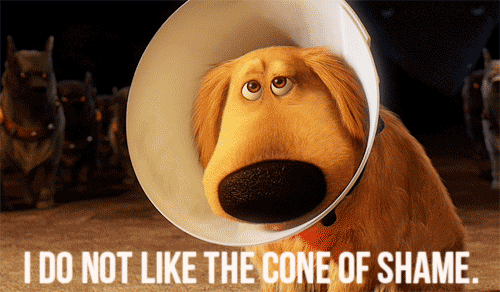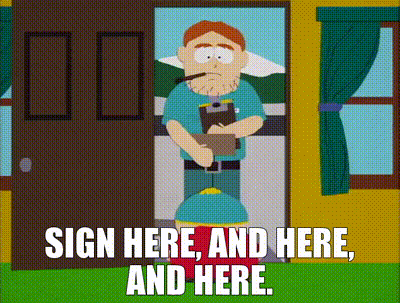That time we considered the dark side… again.
Dark patterns (designs that take advantage of your cognitive biases to manipulate you or deceive you) are everywhere. And, as we talked about in our last blog post, governments are increasingly taking note to eradicate this type of manipulation. In this post, we'll dive into some more dark patterns, the cognitive bias' they are leveraging, and how to avoid using them in your designs.
Confirm shaming
“I'm sorry that good-looking people like us made you throw up and feel bad about yourself.”
- Derek Zoolander, Zoolander
Using language or visuals to make the user feel shame or fear for not acting or opting out. “I will stay unsecured.” “I don’t care about underprivileged children.” Surprisingly, the reaction I get from many designers around this one is "but I'm just being funny!"
My kids will sometimes say "But I was just..." when trying to get out of being in trouble.
I'll interrupt them with "What does 'just' mean?"
Looking at their feet they'll grumble "I'm just about to get in trouble."
Let's talk about humor for a minute. Humor is very context, culture, and situation-specific, and hence extremely tricky to do well and avoid unintended consequences. I found Zoolander to be an absolutely hilarious romp - my husband, not so much. If you are running a weather app like Carrot, the expectation of snarky humor is established and desired. If you are running a subscription site for coupons....not so much. You have to have a very detailed understanding of your users and consistently establish and reinforce your expectations around communication style and tone (this is why it's critical to have a UX Writing Architect as part of your team to establish guidelines for voice and tone that are integrated in your design system). But I digress.
Social desirability bias is the underlying bias at work here. Social desirability bias leads us to take action or answer questions in a way that makes us appear more favorable to others. This particular bias is one of the big ones to look out for in survey creation or any kind of self-report research - if an answer to a question is perceived as negative or "bad", respondents are less likely to be truthful or to report on the behavior/attitude/feeling accurately. Confirm shaming uses this tendency to bully the user into doing the "right" thing. To avoid confirm shaming, consider your confirmation prompts and remove language that implies wrong-doing on the part of the user. It's important to convey consequences without judgement "Do you want to delete all of your data?" is good. "Do you want to be a sad, lonely, data-less loser?" not so much.
Forced action
“Now, juggle these, do a tap dance, and sing the Catalina Magdalena Lupensteiner Wallabeiner song.” - Drunk Test Policeman, Man with Two Brains
"To access the results of your quiz, just give us your date of birth, blood type, first born child's name, and email address!" "To get the full functionality of your purchase, subscribe to our newsletter!" Forced action is making the user take an action (such as provide additional, unnecessary information, download an app, subscribe to a newsletter) in order to access something they have already purchased or has been promised to them. This pattern leverages the popular sunk-cost bias, which is our tendency to be reluctant to abandon something because we have already invested time and/or money into it. Sunk-cost bias leads us to concede to increasingly ridiculous demands for information or action.
I recently took a personality test (who doesn't love a good personality test, amIright?) and at the end of a 15 minute questionnaire, I was asked for my email address so they could send me the results along with marketing to buy the service and books to tell me how to interpret those results. At no time before or during the lengthy Q&A was I told that I would need to pay anything for my results or provide my email. I declined to give them my information, but that meant I also didn't get the results of my labor filling out the test. To avoid forced action patterns, ensure any asks for information or money are optional or are well-documented upfront. If the lamp doesn't work without also purchasing a cord separately, make sure that's known - and never require an email after purchase.
Subscription trap
“It’s a trap!” - Admiral Ackbar, Return of the Jedi
"To unsubscribe, simply contact our support team between the hours of 3:00am-3:05am local time and provide the account number printed on your original receipt in 1 point type on the 3rd page. Good luck!" "To sign up for your free trial, just give us a valid credit card number so we can start charging your subscription the moment the trial is over but without asking you if you actually want to continue." Subscription traps make it ridiculously hard for someone to cancel a subscription by hiding information on how to cancel or require payment information for free trials that will automatically become subscriptions, forcing users to remember when their trial is up in order to cancel it.
Subscription traps rely less on cognitive biases and more on our forgetfulness and being easily frustrated. By putting the burden of cancellation on the user and making that cancellation as difficult as possible, companies are hoping for that "one more month" they can squeeze out of consumers. Requiring a significant amount of notice in writing (not email), coming into the business "in person", needing an original receipt and so on - all of these lead to a difficult experience in cancellation. Unfortunately, designing experiences in this way is itself leaning into a cognitive bias called Present bias. Present bias is the tendency for people (and companies!) to value short-term gain at the expense of long-term well-being. Creating such a difficult and negative experience for subscription cancellations violates Daniel Kahneman's well-researched Peak-End Rule.
The Peak-End Rule states that our impression of an experience is dictated by the highest or lowest part of that experience and the end. In other words, how someone thinks about your product is not based on an overall ebb and flow of good and bad experiences - it's based on the best/worst thing that happens averaged with the last thing that happens. Not the first, the last.
Failing to design for endings is a huge gap in design and something worth thinking about when you want to make it hard for your competitors to keep the customers they may have enticed away from you, get good reviews from existing and past customers, and ensure positive recommendations and leads to less repeat business and a higher number of negative reviews. To avoid subscription traps, make unsubscribing simple and easy to find and never require financial commitments (even future ones) for a free trial. Ensure the burden is on your program/experience, not on the user.
Interface interference
“Wait a minute. I might just have an idea. They'll be looking for us at Maury's right? But they won't be looking for... not us.” - Derek Zoolander, Zoolander
You get an unwanted ad popup and promptly click the x in the upper right hand corner. Instead of closing the dialog as you expected, that click launches a new tab, replete with blink tags, loud music, and flashy graphics for a product you've never heard of. Because it's a new tab, there's no back button to escape the visual and auditory cacophony assaulting your senses. Interface interference is obscuring/highlighting interface items or taking common interface items and making them behave in ways counter to what is expected in order to misdirect the user’s actions.
This pattern takes advantage of our expectations to trick us into doing something we didn't mean to or shouldn't do. A close button that is the same color as the background, rendering it invisible and making it appear that the only option is the call-to-action "buy" tries to trick us into downloading or purchasing something we didn't want. A close dialog button that actually launches a new tab (or several tabs) with no obvious way out tries to get us to stay on the site and hopefully be tempted by more advertisements. All of these patterns are intended to make you take an action you did not want or intend to take and that will benefit the program not you. Interface interference relies on our ever present information overload by violating conventions we rely on to automate our actions. As a result, we become more susceptible to any number of cognitive biases which can then lead us to make poor decisions. To avoid interface interference, follow established conventions for interface interactions and adhere to the well-documented usability heuristics from Jakob Nielsen.
In our next blog post, we'll talk about Bait and Switch, Drip Pricing, Disguised Advertising and Nagging. Until then, remember to design for good endings and follow those usability heuristics. Happy New Year!



